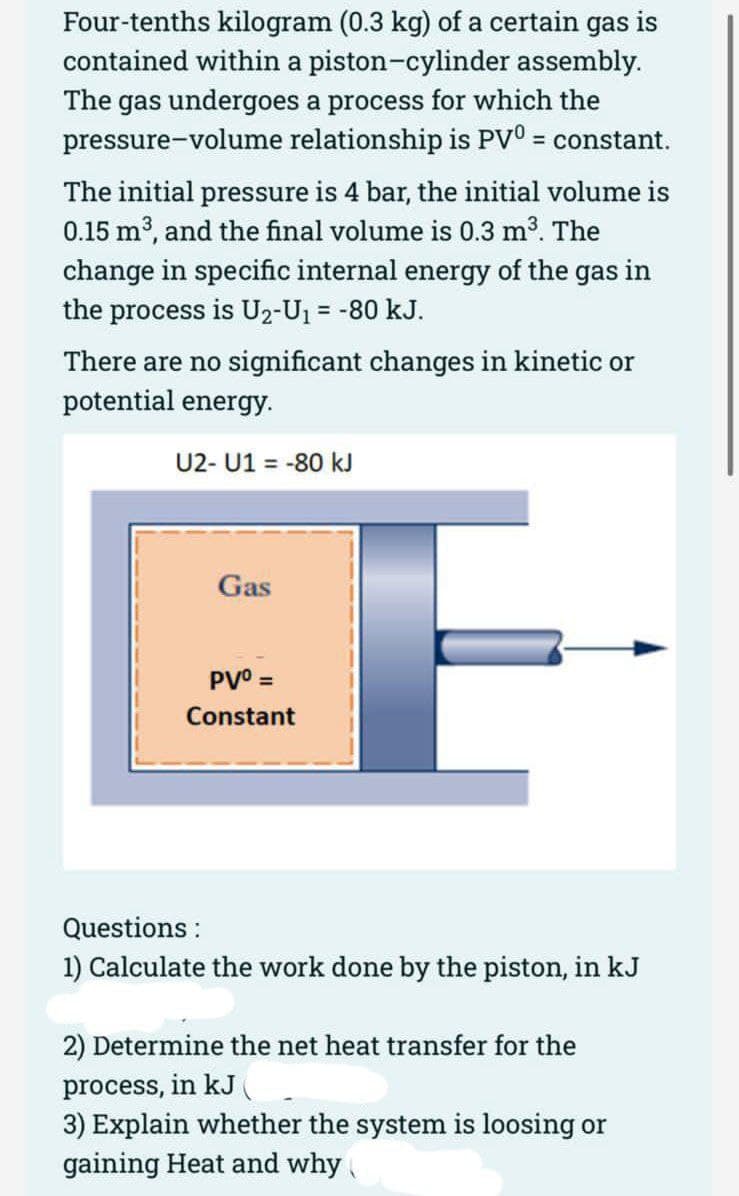Four-tenths kilogram (0.3 kg) of a certain gas is contained within a piston-cylinder assembly. The gas undergoes a process for which the pressure-volume relationship is PV° = constant. The initial pressure is 4 bar, the initial volume is 0.15 m³, and the final volume is 0.3 m3. The change in specific internal energy of the gas in the process is U2-U1 = -80 kJ. There are no significant changes in kinetic or potential energy. U2- U1 = -80 kJ %3D Gas PV = Constant Questions : 1) Calculate the work done by the piston, in kJ 2) Determine the net heat transfer for the process, in kJ( 3) Explain whether the system is loosing or gaining Heat and why
Four-tenths kilogram (0.3 kg) of a certain gas is contained within a piston-cylinder assembly. The gas undergoes a process for which the pressure-volume relationship is PV° = constant. The initial pressure is 4 bar, the initial volume is 0.15 m³, and the final volume is 0.3 m3. The change in specific internal energy of the gas in the process is U2-U1 = -80 kJ. There are no significant changes in kinetic or potential energy. U2- U1 = -80 kJ %3D Gas PV = Constant Questions : 1) Calculate the work done by the piston, in kJ 2) Determine the net heat transfer for the process, in kJ( 3) Explain whether the system is loosing or gaining Heat and why
Elements Of Electromagnetics
7th Edition
ISBN:9780190698614
Author:Sadiku, Matthew N. O.
Publisher:Sadiku, Matthew N. O.
ChapterMA: Math Assessment
Section: Chapter Questions
Problem 1.1MA
Related questions
Question

Transcribed Image Text:Four-tenths kilogram (0.3 kg) of a certain gas is
contained within a piston-cylinder assembly.
The gas undergoes a process for which the
pressure-volume relationship is PV° = constant.
The initial pressure is 4 bar, the initial volume is
0.15 m3, and the final volume is 0.3 m3. The
change in specific internal energy of the gas in
the process is U2-U1 = -80 kJ.
There are no significant changes in kinetic or
potential energy.
U2- U1 = -80 kJ
Gas
PVO =
Constant
Questions :
1) Calculate the work done by the piston, in kJ
2) Determine the net heat transfer for the
process, in kJ
3) Explain whether the system is loosing or
gaining Heat and why
Expert Solution
This question has been solved!
Explore an expertly crafted, step-by-step solution for a thorough understanding of key concepts.
This is a popular solution!
Trending now
This is a popular solution!
Step by step
Solved in 2 steps with 4 images

Knowledge Booster
Learn more about
Need a deep-dive on the concept behind this application? Look no further. Learn more about this topic, mechanical-engineering and related others by exploring similar questions and additional content below.Recommended textbooks for you

Elements Of Electromagnetics
Mechanical Engineering
ISBN:
9780190698614
Author:
Sadiku, Matthew N. O.
Publisher:
Oxford University Press

Mechanics of Materials (10th Edition)
Mechanical Engineering
ISBN:
9780134319650
Author:
Russell C. Hibbeler
Publisher:
PEARSON

Thermodynamics: An Engineering Approach
Mechanical Engineering
ISBN:
9781259822674
Author:
Yunus A. Cengel Dr., Michael A. Boles
Publisher:
McGraw-Hill Education

Elements Of Electromagnetics
Mechanical Engineering
ISBN:
9780190698614
Author:
Sadiku, Matthew N. O.
Publisher:
Oxford University Press

Mechanics of Materials (10th Edition)
Mechanical Engineering
ISBN:
9780134319650
Author:
Russell C. Hibbeler
Publisher:
PEARSON

Thermodynamics: An Engineering Approach
Mechanical Engineering
ISBN:
9781259822674
Author:
Yunus A. Cengel Dr., Michael A. Boles
Publisher:
McGraw-Hill Education

Control Systems Engineering
Mechanical Engineering
ISBN:
9781118170519
Author:
Norman S. Nise
Publisher:
WILEY

Mechanics of Materials (MindTap Course List)
Mechanical Engineering
ISBN:
9781337093347
Author:
Barry J. Goodno, James M. Gere
Publisher:
Cengage Learning

Engineering Mechanics: Statics
Mechanical Engineering
ISBN:
9781118807330
Author:
James L. Meriam, L. G. Kraige, J. N. Bolton
Publisher:
WILEY